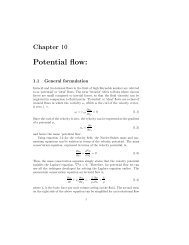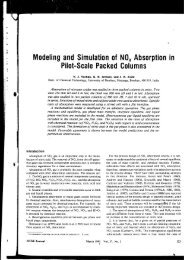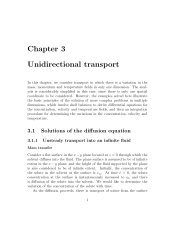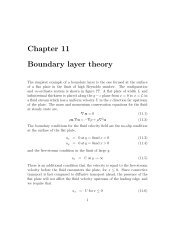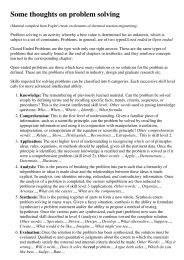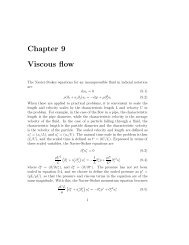Chapter 5 Steady and unsteady diffusion
Chapter 5 Steady and unsteady diffusion
Chapter 5 Steady and unsteady diffusion
Create successful ePaper yourself
Turn your PDF publications into a flip-book with our unique Google optimized e-Paper software.
20 CHAPTER 5. STEADY AND UNSTEADY DIFFUSION<br />
5.2.6 Temperature distribution due to a dipole<br />
Consider a source <strong>and</strong> sink of energy, of equal strength, ±Q of energy per unit<br />
time, located at the positions (0, 0, L) <strong>and</strong> (0, 0, −L), as shown in figure 5.10.<br />
The temperature field due to the combination of source <strong>and</strong> sink is given by<br />
Q<br />
T(x) =<br />
4πK(x 2 + y 2 + (z − L) 2 ) +<br />
−Q<br />
(5.61)<br />
1/2 4πK(x 2 + y 2 + (z + L) 2 ) 1/2<br />
If the distance of the observation point from the origin is sufficiently large,<br />
so that the (x, y, z) ≫ L, the temperature field is given by<br />
T(x) =<br />
Q<br />
4πK<br />
= 2QL<br />
4πK<br />
2Lz<br />
(x 2 + y 2 + z 2 ) 1/2<br />
cos (θ)<br />
r 2<br />
= 2QL<br />
4πK r−2 P 1 (cos (θ)) (5.62)<br />
Thus, the temperature distribution due to the combination of a source <strong>and</strong><br />
a sink, in the limit where the distance between the two reduces to zero, is<br />
identical to the second spherical harmonic solution that was obtained for the<br />
Laplace equation. Similarly, it can be shown that the combination of two<br />
sources <strong>and</strong> two sinks, arranged in such a way that the net dipole moment<br />
is zero, corresponds to the third spherical harmonic solution for the Laplace<br />
equation.<br />
5.2.7 Boundary integral technique<br />
In order to solve the steady temperature equation,<br />
we can use a Greens function<br />
∇ 2 T = −S(x) (5.63)<br />
∇ 2 G = δ(x) (5.64)<br />
which is defined according to the required boundary conditions on the domain,<br />
as follows.<br />
∫<br />
dV ′ ∇.(T(x ′ )∇G(x − x ′ ) − G(x − x ′ )∇ ′ T(x ′ ))<br />
∫<br />
= dV ′ (T(x ′ )∇ ′2 G(x − x ′ ) − G(x − x ′ )∇ ′2 T(x ′ ))<br />
= (5.65)





